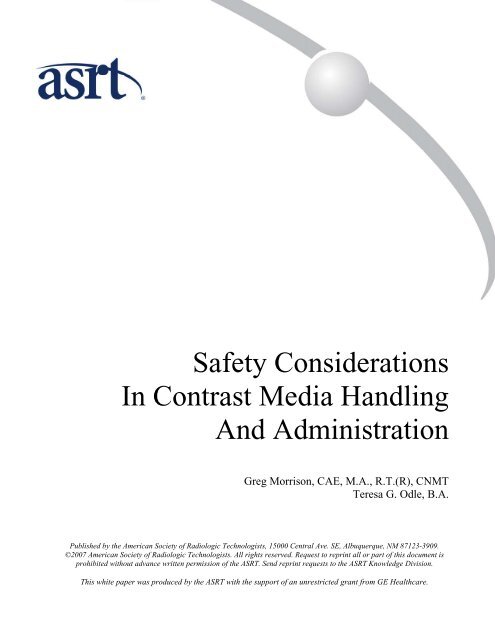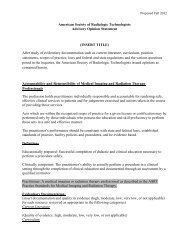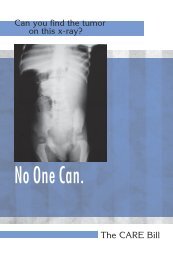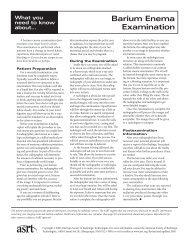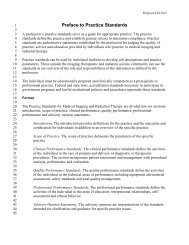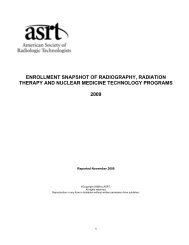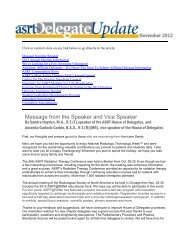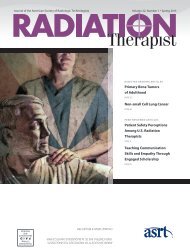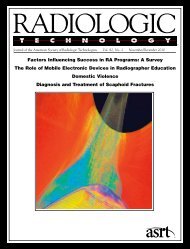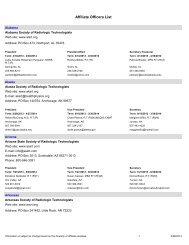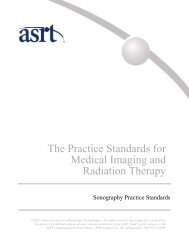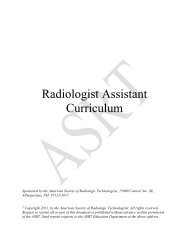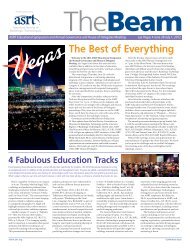Safety Considerations In Contrast Media Handling And Administration
Safety Considerations In Contrast Media Handling And Administration
Safety Considerations In Contrast Media Handling And Administration
You also want an ePaper? Increase the reach of your titles
YUMPU automatically turns print PDFs into web optimized ePapers that Google loves.
<strong>Safety</strong> <strong>Considerations</strong><br />
<strong>In</strong> <strong>Contrast</strong> <strong>Media</strong> <strong>Handling</strong><br />
<strong>And</strong> <strong>Administration</strong><br />
Greg Morrison, CAE, M.A., R.T.(R), CNMT<br />
Teresa G. Odle, B.A.<br />
Published by the American Society of Radiologic Technologists, 15000 Central Ave. SE, Albuquerque, NM 87123-3909.<br />
©2007 American Society of Radiologic Technologists. All rights reserved. Request to reprint all or part of this document is<br />
prohibited without advance written permission of the ASRT. Send reprint requests to the ASRT Knowledge Division.<br />
This white paper was produced by the ASRT with the support of an unrestricted grant from GE Healthcare.
<strong>Safety</strong> <strong>Considerations</strong> in <strong>Contrast</strong> <strong>Media</strong><br />
<strong>Handling</strong> and <strong>Administration</strong><br />
<strong>In</strong>troduction<br />
<strong>Contrast</strong> media are used yearly in millions of radiological examinations in North<br />
America, with some radiologic technologists administering contrast daily. 1,2 Recent<br />
attention has focused on intravascular ionic high-osmolality contrast material and its<br />
potential for causing patient reactions. This topic has been covered thoroughly in other<br />
publications such as the American College of Radiology (ACR) “Manual on <strong>Contrast</strong><br />
<strong>Media</strong>.” 1,3<br />
This paper outlines the issues that surround contrast media handling, administration and<br />
the role of radiologic technologists in contrast safety. The information can serve as the<br />
basis for dialogue and a focus on patient and R.T. safety in contrast use for institutions<br />
and other organizations interested in and influencing safety initiatives.<br />
The significance of contrast media in medical imaging is unquestionable. <strong>Contrast</strong> is<br />
invaluable in helping distinguish the body’s organs and tissues and is contributing to the<br />
increased effectiveness of diagnostic imaging. 2 Yet the high use of contrast in imaging<br />
comes with a great deal of responsibility. Radiologic technologists are charged with<br />
ensuring patient safety while also paying close attention to actions that protect their own<br />
safety and well-being as health care workers.<br />
A 1999 report from the <strong>In</strong>stitute of Medicine (IOM) titled To Err is Human: Building a<br />
Safer Health System laid the groundwork for a focus on quality in health care and<br />
preventable deaths from medical errors. 4 An IOM 2001 follow-up report (Crossing the<br />
Quality Chasm: A New Health System for the 21st Century) suggested improvements in<br />
patient care quality and safety. 5 These efforts raised the awareness of health care leaders,<br />
health care workers and patients concerning safe practices in hospitals and other health<br />
care settings.<br />
As recognition of the threat posed to health care workers by exposure to human<br />
immunodeficiency virus (HIV) and other infectious agents increased, health care<br />
facilities and organizations renewed their focus on occupational safety. The Occupational<br />
<strong>Safety</strong> and Health <strong>Administration</strong> (OSHA) issued the Bloodborne Pathogens Standard in<br />
1991 to protect health care workers from exposure risk. 6 OSHA also remains alert to<br />
other employee health issues.<br />
<strong>In</strong> fact, a number of agencies and associations provide standards and guidelines that<br />
affect how a radiologic technologist handles and administers contrast medium. These<br />
©2007 American Society of Radiologic Technologists. All rights reserved.
<strong>Safety</strong> <strong>Considerations</strong> in <strong>Contrast</strong> <strong>Media</strong> <strong>Handling</strong> and <strong>Administration</strong><br />
standards serve primarily to ensure that the patient receives a safe, high-quality<br />
examination, while also keeping the technologist out of harm’s way.<br />
At times the various regulations and standards can be confusing in that each technologist<br />
must adhere to guidelines that range from federal government and accrediting body<br />
regulations, to clinical association practice guidelines, and to varying state and<br />
institutional policies. Technologists must rely on management and reputable sources to<br />
help them sort through a range of varied guidance mechanisms to identify, rank and<br />
clarify specific departmental guidelines that apply to contrast handling, administration<br />
and sentinel event action and reporting. 7<br />
Evaluating <strong>Safety</strong> <strong>Considerations</strong><br />
Questions raised with the American Society of Radiologic Technologists (ASRT) Office<br />
of Practice Issues, along with a desire to focus on patient safety, led the Society to initiate<br />
a series of efforts concerned with handling and administering contrast. On April 23, 2007,<br />
the ASRT gathered a group of participants in Albuquerque, N.M., for a full-day<br />
discussion of safety considerations related to handling, storing and administering contrast<br />
media. The meeting included a review of regulations that influence how contrast media<br />
are handled and administered, an open conversation on safety concerns related to contrast<br />
media, a report on the ASRT <strong>Contrast</strong> <strong>Administration</strong> <strong>Safety</strong> Survey and a discussion of<br />
the next steps needed to improve safety.<br />
Regulatory hierarchy<br />
ASRT Health Policy Manager Peter Shams-Avari presented the authority hierarchy that<br />
radiologic technologists must follow when handling and administering contrast media:<br />
• Federal and state laws.<br />
• Accreditation standards.<br />
• <strong>In</strong>stitutional policy and customary practice within the jurisdiction.<br />
• Practice guidelines and standards developed by professional organizations. 8<br />
The order of authority helps radiologic technologists and those who manage medical<br />
imaging centers and departments set up the appropriate policies and procedures regarding<br />
contrast handling and administration. Mr. Shams-Avari also reviewed the authority of<br />
scope of practice for contrast administration. The issue of the radiologic technologist<br />
scope of practice in administering contrast provides an excellent example of the<br />
confusion caused by the many variables involved. The ASRT Office of Practice Issues<br />
has received calls from people puzzled about the differences, according to Mr. Shams-<br />
Avari. A survey of state laws revealed that more than one-half of states do not address<br />
who may administer contrast. 8 The ASRT considers contrast administration and<br />
venipuncture within the radiologic technologist’s scope of practice “with appropriate<br />
clinical and didactic education where state statutes and/or institutional policy permit.” 9<br />
2<br />
©2007 American Society of Radiologic Technologists. All rights reserved.
<strong>Safety</strong> <strong>Considerations</strong> in <strong>Contrast</strong> <strong>Media</strong> <strong>Handling</strong> and <strong>Administration</strong><br />
When questions come up regarding the radiologic technologist's role in administering<br />
contrast at individual institutions, many medical imaging leaders turn to ASRT standards<br />
and policy statements for guidance. 8 Hospitals generally should begin by incorporating<br />
regulations from OSHA and The Joint Commission. Some also seek further guidance<br />
from <strong>In</strong>ternet bulletin boards and list servers, which can provide erroneous information.<br />
<strong>In</strong>stitutions also must remain up-to-date and must balance policy with actual practice,<br />
said Mr. Shams-Avari.<br />
Although freestanding imaging centers and private physician offices may apply for<br />
voluntary accreditation, the standards are not the same as those applied to hospitals. R.T.s<br />
also have asked questions about scope of practice, ethics and who should supervise<br />
them. 8<br />
<strong>Contrast</strong> safety discussion and survey results<br />
The ASRT gathered information on contrast safety to prepare for these discussions and<br />
presented the findings to meeting participants. <strong>In</strong> 2005, the ASRT Education and<br />
Research Foundation conducted a survey of 1,501 respondents who either were involved<br />
in administering iodinated contrast media or who supervised others who administered<br />
contrast. The survey focused primarily on injuries related to contrast packaging and on<br />
the volume of procedures. Findings from the survey were used in the contrast safety<br />
meeting discussion and are incorporated into these findings.<br />
The discussion about regulations and guidelines concerning contrast media safety<br />
expanded into issues of a broad range, including: scope of practice, packaging and<br />
labeling, patient safety, patient hand-off communication, R.T. injury prevention and<br />
universal precautions, storage and disposal, cost-effectiveness and education.<br />
Meeting participants agreed that the focus on patient safety, contrast media safety and<br />
other regulations and standards has created a sort of “perfect storm” for addressing the<br />
issues and questions that surround contrast media handling and administration.<br />
Participants agreed that a proactive approach to issues outlined in this document is<br />
preferred to continued confusion and the potential risk and financial results of<br />
inconsistent approaches to safety issues. A proactive approach also demonstrates that the<br />
ASRT and the radiologic technology profession are taking a professional approach to<br />
contrast safety vs. waiting for additional regulatory solutions to be imposed by outside<br />
agencies or accrediting bodies. 7<br />
<strong>Safety</strong> <strong>In</strong>itiatives, Guidelines and Regulations<br />
Although relatively few of the millions of intravenous injections of contrast media per<br />
year in North America cause an adverse reaction, (5% to 12% with ionic high-osmolality<br />
contrast media and 3% or less of injections with low-osmolality) 1 these examinations<br />
receive a great deal of attention. A national focus on patient safety has resulted in<br />
regulatory and accreditations standards aimed at improving patient safety.<br />
3<br />
©2007 American Society of Radiologic Technologists. All rights reserved.
<strong>Safety</strong> <strong>Considerations</strong> in <strong>Contrast</strong> <strong>Media</strong> <strong>Handling</strong> and <strong>Administration</strong><br />
Federal agencies that regulate how contrast is stored, handled and administered include<br />
OSHA, the Centers for Disease Control and Prevention (CDC) and the Centers for<br />
Medicare & Medicaid Services (CMS). OSHA develops and enforces workplace safety<br />
regulations. The CDC is the primary agency responsible for protecting the health and<br />
safety of the American public. Within the CDC is the National <strong>In</strong>stitute for Occupational<br />
<strong>Safety</strong> and Health (NIOSH), which also is concerned with safe and healthy working<br />
conditions. CMS establishes certain quality standards, such as survey and certification<br />
processes and enforces the Health <strong>In</strong>surance Portability and Accountability Act<br />
(HIPAA). 10<br />
Bloodborne Pathogens Standard<br />
Important to contrast administration is the Bloodborne Pathogens Standard. Issued in<br />
1991 and revised in 2001 in response to the Needlestick <strong>Safety</strong> and Prevention Act, the<br />
standard “recognizes that needle-stick injuries and other sharps-related injuries that<br />
expose health care workers to blood-borne pathogens continue to be an important public<br />
health concern.” 6 The act, which is enforced by OSHA, covers work practice controls to<br />
minimize employee exposure to blood-borne pathogens, as well as documentation and<br />
follow-up should an exposure occur. 6<br />
OSHA reports that approximately one-half of the states and territories have adopted their<br />
own standards and policies concerning blood-borne pathogens and that, for the most part,<br />
these standards are identical to the federal standards. But in some cases, state laws differ;<br />
and when they do, they must be at least as stringent as federal regulations. 6<br />
<strong>Contrast</strong> agents as pharmaceuticals<br />
All contrast agents are classified as pharmaceuticals. As a result, they are listed in the<br />
National Drug Code and must meet U.S. Food and Drug <strong>Administration</strong> requirements. 10<br />
The Patient <strong>Safety</strong> and Quality Improvement Act signed into law in July 2005 provides a<br />
legal privilege to obtain information about medical errors and other adverse events<br />
reported to patient safety organizations. 11 All federal and state guidelines on storing,<br />
labeling, packaging and handling of pharmaceuticals apply to contrast media. 10 State laws<br />
regarding medical, nursing and radiologic technologist practice also may apply to<br />
contrast administration. 8<br />
Accreditation standards and guidelines<br />
Unlike OSHA regulations, accreditation standards are voluntary, 10 at least at the<br />
institutional level. A hospital may elect to obtain accreditation from The Joint<br />
Commission, thus making Joint Commission standards voluntary. However, hospital and<br />
departmental leadership may argue that achieving accreditation is not voluntary,<br />
particularly when contracts from certain payers and other business matters hinge on<br />
continued accreditation.<br />
4<br />
©2007 American Society of Radiologic Technologists. All rights reserved.
<strong>Safety</strong> <strong>Considerations</strong> in <strong>Contrast</strong> <strong>Media</strong> <strong>Handling</strong> and <strong>Administration</strong><br />
The Joint Commission publishes goals and requirements and identifies unsafe practices<br />
through sentinel reporting. The Joint Commission defers to regulatory agencies when any<br />
agency’s regulations take precedence in the matter. 10 <strong>In</strong> 2004, the Joint Commission<br />
began considering contrast agents as diagnostic medications and applied all standards<br />
regarding medications to contrast media. This standard leaves decisions on who may<br />
administer contrast to the discretion of the institution. A few institutions have been cited<br />
for allowing radiologic technologists to administer contrast. However, in each instance<br />
the institution had not included radiologic technologists in the policies and procedures. <strong>In</strong><br />
effect, this caused the institution to be noncompliant. 12<br />
The Joint Commission has specified National Patient <strong>Safety</strong> Goals to promote specific<br />
improvements related to patient safety. <strong>In</strong> May 2007, the World Health Organization<br />
adopted nine patient safety solutions that apply to patient safety and best practices in<br />
reducing patient risk to a broader, world audience. The Joint Commission is a<br />
collaborating center. 13 Joint Commission/WHO patient safety goals that apply to contrast<br />
media include look-alike, sound-alike medications, communication during patient handovers,<br />
ensuring medication accuracy, single use of injection devices and improved hand<br />
hygiene. 13,14<br />
At the institutional level, policies and procedures that concern contrast storage, handling<br />
and administration should be based on appropriate regulations and accreditation<br />
standards. <strong>In</strong>stitutions also may include input and information from professional<br />
organizations. The ACR publishes guidelines for using intravascular contrast media and a<br />
manual on contrast media. The ACR also supplies guidelines, appropriateness criteria and<br />
position statements concerning many aspects of imaging, safety, quality, communication,<br />
patient education and infection control. 1,15,16 <strong>In</strong> addition, the organization performs<br />
voluntary accreditation of sites where contrast is administered, such as computed<br />
tomography (CT) and magnetic resonance imaging (MR). 17<br />
As the professional organization for radiologic technologists, the ASRT remains involved<br />
in making position statements and setting practice standards and scope of practice<br />
parameters for R.T.s. When institutional policies are being set, leaders often look for<br />
guidance in the statements and standards of professional organizations such as the ACR<br />
and the ASRT. 8,18<br />
The <strong>Safety</strong> Challenge<br />
<strong>In</strong> addition to regulatory demands for safety and improvement, national organizations<br />
have introduced quality and patient safety initiatives. At the institutional level, hospitals<br />
and freestanding imaging centers have responded by launching safety and improvement<br />
initiatives. 5 Yet in spite of the IOM reports and a focus on safety, little has been<br />
accomplished to improve safety in many hospitals. This largely may be due to a greater<br />
tendency of boards of trustees and top management to focus more on the financial status<br />
of their hospitals than on safety issues. <strong>In</strong> addition, an environment that reinforces safe<br />
behaviors and leads to reporting of errors, as well as to determining their root cause,<br />
helps promote safer practices. 4 Many who study safety issues refer to this as a “culture of<br />
safety.” 4,5<br />
5<br />
©2007 American Society of Radiologic Technologists. All rights reserved.
<strong>Safety</strong> <strong>Considerations</strong> in <strong>Contrast</strong> <strong>Media</strong> <strong>Handling</strong> and <strong>Administration</strong><br />
According to a recent article by Carroll and Rudolph in the journal Quality and <strong>Safety</strong> in<br />
Health Care, safety is an organizational goal that is particularly challenging because:<br />
• Primary service and production goals may compete or be perceived as competing<br />
with safety.<br />
• Activities related to primary service and production immediately affect the bottom<br />
line and can be quantitatively measured. <strong>Safety</strong> often is a “dramatic nonevent”<br />
produced by workers making continual, unseen and small adjustments that may be<br />
more difficult to define and measure.<br />
• As safety improves, the decreasing frequency of problems and sentinel events may<br />
lead to complacency and divert focus and resources.<br />
• Managing daily work – as well as the occasional unique problems – requires time,<br />
skill and technique and competes for managers’ attention.<br />
• Champions for safety often are outside the organization – regulators, citizens’ groups<br />
or unfamiliar safety specialists who may be seen as interfering with an organization’s<br />
legitimate service and production. 19<br />
Safe <strong>Contrast</strong> <strong>Administration</strong><br />
Administering contrast agents during imaging procedures introduces the possibility for<br />
adverse events that may affect patients or health care workers. Those events that are<br />
reported may be related to errors in prescribing, errors in administration related to<br />
misreading of contrast agents or the order, or errors caused by communication involved<br />
in patient hand-off. Needle-stick injuries also may occur to radiologic technologists<br />
during intravenous injection of contrast agents.<br />
Medication errors that affect patients<br />
Medication errors are common in health care facilities, with a reported occurrence rate of<br />
nearly 20%. 11 The U.S. Pharmacopeia’s MedMarx program is an anonymous, voluntary,<br />
subscription-based reporting program that collects and analyzes health care medication<br />
errors. From 2000 to 2004, the program recorded 2,032 reports from 315 hospitals and<br />
clinics of medication errors associated with radiology. About 81% of these errors reached<br />
the patient and 12% caused harm.<br />
The USP pointed out that even though the total number of errors was low in relation to<br />
the total volume in radiology departments, the percentage of errors that caused harm was<br />
significantly higher than for other health care departments, which averaged 1.7% of<br />
errors causing harm. Improper dose or quantity of medication was the most frequent and<br />
harmful type of error and often was related to reprogramming IV pumps following a<br />
procedure. Nine of the top 25 most frequently reported drugs involved in medication<br />
errors were contrast agents. 11<br />
6<br />
©2007 American Society of Radiologic Technologists. All rights reserved.
<strong>Safety</strong> <strong>Considerations</strong> in <strong>Contrast</strong> <strong>Media</strong> <strong>Handling</strong> and <strong>Administration</strong><br />
Many errors in administering contrast and other drugs in the radiology department result<br />
from poorly defined standing orders, inadequate communication during transport or<br />
patient hand-off, and other communication breakdowns. USP says that performance<br />
deficit causes 47% of medication errors, which is an error that cannot be attributed to a<br />
specific cause. <strong>In</strong> other words, the person who administered the drug is educated or<br />
trained in its administration and should have known better. 11<br />
Improving communication among caregivers is a National Patient <strong>Safety</strong> Goal of the<br />
Joint Commission. <strong>In</strong> particular, implementing a standardized approach to “hand-off”<br />
communications that includes the ability to ask and respond to questions is a national<br />
goal. Cumberland Medical Center in Crossville, Tenn., has developed a “Ticket to Ride”<br />
program to comply with the Joint Commission’s hand-off communications goal. Nurses<br />
list all medications on a form that accompanies inpatients to the radiology department.<br />
The emergency department was excepted, but implemented an electronic record that<br />
facilitated communication. 7 (Cathy L. Parsons, B.S., R.T.(R)(M)(QM), FASRT, e-mail,<br />
July 9, 2007.)<br />
The Joint Commission’s National Patient <strong>Safety</strong> Goal on effective hand-off<br />
communication provides implementation expectations for hospitals to follow, such as<br />
repeating back information they receive. 12,14<br />
Primary care physicians may not be well-versed on contrast agent use and dosing. 7 The<br />
radiologic technologist’s role in how an institution reconciles medication procedures is<br />
limited to adding contrast agents and other medications to an on-going list of medicines<br />
administered to the patient. Any added role would be beyond the radiologic technologist<br />
scope of practice. 12<br />
ASRT standards for radiography and CT state that the radiologic technologist<br />
“determines appropriate type and dose of contrast agent to be administered, based on the<br />
patient’s age, weight and medical/physical status.” 18 A radiologist generally reviews<br />
prescription orders for contrast administered in radiology. If contrast is administered<br />
outside radiology, a pharmacist should review the order. 10<br />
Errors related to labeling and documentation<br />
An additional source of medication and contrast administration errors in radiology is<br />
confusion caused by labeling and product coding. The FDA stated that a combined 39%<br />
of medication errors reported to the agency in 2001 were caused by name confusion,<br />
labeling or packaging/design. <strong>In</strong> a 2004 final ruling, the agency subsequently required bar<br />
codes on all drugs. 20,21 The USP reports that some drug administration errors involving<br />
contrast are caused by unlabeled open containers on the sterile field, along with confusion<br />
over look-alike products. 11<br />
The Joint Commission’s National Patient <strong>Safety</strong> Goals regarding medication safety<br />
include labeling all medications, medication containers and other solutions on and off the<br />
7<br />
©2007 American Society of Radiologic Technologists. All rights reserved.
<strong>Safety</strong> <strong>Considerations</strong> in <strong>Contrast</strong> <strong>Media</strong> <strong>Handling</strong> and <strong>Administration</strong><br />
sterile field. This includes medication/contrast that is transferred from the original<br />
package to a new container. 10,22 However, contrast that is drawn into a power injector and<br />
administered immediately does not need a label. Yet, if contrast is transferred from its<br />
original container and not administered immediately, it must be labeled, whether it is<br />
administered manually or by power injector. 22 The goal also requires that organizations<br />
identify and review, at least annually, a list of look-alike/sound-alike drugs used by the<br />
organization and take action to prevent errors that involve interchanging these drugs. 14<br />
These goals apply to contrast agents. 23<br />
The intent of the look-alike/sound-alike goal is to avoid confusing different drug<br />
preparations. The Joint Commission says this includes different strengths of the same<br />
drug. 22 Redundancy and double checks are methods the Joint Commission recommends<br />
for verifying medication name and concentration.<br />
Documenting contrast administration and patient complications is necessary to ensure<br />
patient safety. Required documentation includes the contrast agent name and dose<br />
amount, along with the date, time and method of administration. The injection site and<br />
number of attempts also must be recorded. 2 Some contrast packaging comes with peel-off<br />
labels that can be applied directly to a patient’s record. 7 Richelle Heldwein, M.P.H.,<br />
R.T.(R), director of risk management at Portneuf Medical Center in Pocatello, Idaho,<br />
says that it would be very valuable to have stickers that identify what medication the<br />
patient was given, the dose, lot number, etc. (R. Heldwein, oral communication, July 3,<br />
2007.)<br />
Needle-stick exposures<br />
It is estimated that 600,000 to 800,000 needle-stick and other percutaneous injuries are<br />
reported among U.S. health care workers each year. 24 Sharps injuries constitute one-third<br />
of all reported hospital injuries. 25 It is widely agreed that needle-stick incidents are underreported,<br />
26,27,28 but that the injuries pose a small yet nonetheless significant risk of<br />
potentially fatal blood-borne viruses. 26,29<br />
Exposure through needle sticks or cuts from other sharp objects contaminated with a<br />
patient’s blood can lead to:<br />
• Hepatitis B. For those susceptible to hepatitis B, the risk from a single exposure to an<br />
infected person ranges from 6% to 30%, depending on the antigen status of the source<br />
individual.<br />
• Hepatitis C. Risk after exposure to hepatitis C-infected blood is approximately 1.8%.<br />
• HIV. The average risk of HIV infection after exposure to infected blood is about<br />
.3%. 29<br />
Reports show that most injuries occur from syringes. However, when rates are calculated<br />
to reflect injury per use, intravenous (IV) catheter stylets cause the most needle-stick<br />
8<br />
©2007 American Society of Radiologic Technologists. All rights reserved.
<strong>Safety</strong> <strong>Considerations</strong> in <strong>Contrast</strong> <strong>Media</strong> <strong>Handling</strong> and <strong>Administration</strong><br />
injuries. 28 Data from the Exposure Prevention <strong>In</strong>formation Network (EPINet) for 2003<br />
reported the highest rate (37.8%) of needle-stick incidents among nurses. Although no<br />
category specifically exists in the data for radiologic technologists, a category titled<br />
“technologists, nonlab” represents 4.7% of all needle sticks among health care workers.<br />
Approximately 90% of all occurrences involved a sharp item that was contaminated.<br />
EPINet data reflect occupational exposures from 70 U.S. hospitals. Most needle-stick<br />
injuries occurred on the hands during sharps use or between steps. 30 The ASRT <strong>Contrast</strong><br />
<strong>Administration</strong> <strong>Safety</strong> Survey conducted in 2005 revealed that 69.4% of respondents had<br />
reported a work area sharps injury within the past year. 31<br />
Developing safer needle devices and systems is not just a good idea to promote safety; it's<br />
also an OSHA charge. The Needlestick <strong>Safety</strong> and Prevention Act requires that<br />
employers solicit input on identifying and choosing safety devices for nonmanagerial<br />
employees who perform procedures in which they are exposed to sharps. 7,32 <strong>In</strong>troducing<br />
needle containers, needleless infusion systems, and devices with safety features such as<br />
blunting, shielding or retracting mechanisms reportedly reduces the risk of needle<br />
sticks. 25,28 Thirty-five percent of contrast safety survey participants who relied primarily<br />
on prefilled syringes for hand-held injection cited safety as the reason for using the<br />
product. 31 <strong>In</strong> 2003, OSHA imposed fines on two facilities for failure to use safetyengineered<br />
devices. 33<br />
Blood spatters on mucous membranes of the eye, nose or mouth also pose a risk of<br />
infectious disease, although the risk is less than from a needle-stick exposure. 25,29 Nearly<br />
30% of ASRT contrast safety survey participants reported incidents of eye splatter from<br />
contrast media. 31<br />
<strong>In</strong>fection control<br />
Sound infection control policies at the institutional level help prevent infection from<br />
blood-borne pathogens, along with other types of hospital-acquired infections such as<br />
methicillin-resistant Staphylococcus aureus (MRSA). 16,34 Universal precautions are<br />
recognized internationally as an effective way to protect health care workers, patients and<br />
the general public by reducing hospital-acquired infection rates. Universal precautions<br />
include health care workers routinely using barrier precautions to prevent contamination<br />
from blood and specific body fluids known to be contaminated. Standard precautions are<br />
similar, but apply to all body fluids except sweat. They do not take into account the<br />
possibility of bleeding, broken skin or mucous membranes. However, both types of<br />
precautions generally fall under the “universal” term. 34<br />
All health care workers should strictly follow aseptic techniques and standard precautions<br />
for hand washing, using protective barriers and appropriately disposing of needles and<br />
other sharp instruments. 35 A number of studies have shown that health care workers do<br />
not adequately understand and interpret universal precautions. 34<br />
Reporting needle-stick injuries<br />
9<br />
©2007 American Society of Radiologic Technologists. All rights reserved.
<strong>Safety</strong> <strong>Considerations</strong> in <strong>Contrast</strong> <strong>Media</strong> <strong>Handling</strong> and <strong>Administration</strong><br />
A misunderstanding of universal precautions may help explain why needle-stick injuries<br />
are under-reported. Reasons cited in various studies for not reporting needle-stick injuries<br />
include: no use in reporting, the amount of time involved, the stigma associated with<br />
reporting and not wanting to know results. 24 ASRT <strong>Contrast</strong> <strong>Administration</strong> <strong>Safety</strong><br />
Survey respondents listed “thought injury was low risk” as their primary reason (41.9%)<br />
for not reporting injuries from sharp objects. About 13% of respondents cited time as the<br />
factor for not reporting. 31 Others have expressed concerns about the responses of their<br />
supervisors and institutions to reports of needle-stick injuries. 27<br />
OSHA requires that workers “record all work-related needle-stick injuries and cuts from<br />
sharp objects that are contaminated with another person’s blood or other potentially<br />
infectious material.” The agency states that facilities must report only the cuts,<br />
lacerations, punctures and scratches that are work-related and involve contamination.<br />
<strong>In</strong>juries involving a clean object or a contaminant other than blood or potentially<br />
infectious materials only need to be recorded if they result in significant injury, time off<br />
from work, etc. 36<br />
Most infection control policies include follow-up procedures after a needle-stick<br />
exposure is reported. Procedures begin with immediately flooding the area with water<br />
and cleaning the wound with water and skin disinfectant or soap. After reporting the<br />
incident and seeking medical attention, testing and treatment are determined by the type<br />
and level of suspected exposure. 37<br />
Safe Storage and <strong>Handling</strong> of <strong>Contrast</strong><br />
Safely storing and handling contrast material presents a range of concerns that include,<br />
but are not limited to: patient medication errors caused by poor storage practices;<br />
employee safety problems caused by contrast material packaging; and ergonomics and<br />
safety concerns for radiologic technologists in handling contrast packaging.<br />
Storage of contrast agents<br />
Although contrast media are subject to the same regulatory and accrediting body<br />
requirements as other drugs, storing and handling contrast may not be included in<br />
hospital policies that concern medication storage. That makes medical imaging<br />
departments a target of reviewers. 12<br />
Joint Commission standards and patient safety goals that concern look-alike/sound-alike<br />
medications, as well as labeling recommendations, also apply to storing contrast.<br />
Recommendations include physically separating medications with look-alike/sound-alike<br />
names in all storage areas and using “tall man,” or mixed case lettering, to emphasize<br />
drug name differences. Storing problem medications separately and using color coding<br />
helps prevent confusion. 38 Medication errors reported to the U.S. Pharmacopeia often<br />
involved storage, restocking and dispensing issues. Documenting and tracking contrast<br />
agents as medications also is critical during the storage phase, as drugs expire, are<br />
recalled or if they are improperly stocked. 7,11<br />
10<br />
©2007 American Society of Radiologic Technologists. All rights reserved.
<strong>Safety</strong> <strong>Considerations</strong> in <strong>Contrast</strong> <strong>Media</strong> <strong>Handling</strong> and <strong>Administration</strong><br />
Storage also involves concerns about who can access the storage area, including contrast<br />
warmers. Only appropriate staff should be allowed access. Also, contrast should be<br />
removed from its packing carton then stored no higher than 18 inches from the ceiling. 10<br />
Ergonomics<br />
OSHA recommends that employers identify and address ergonomic stressors in the<br />
workplace and that management assess work tasks that increase risk for injury. 39 <strong>In</strong> a<br />
2001 ASRT survey on workplace issues, 19% of R.T.s indicated that increased workloads<br />
caused by personnel shortages had led to ergonomic problems. 40 Radiologic technologists<br />
risk injury from repetitive motion activities and lifting patients. 39 Common problems<br />
include carpal tunnel syndrome, back pain and tendonitis. 10<br />
<strong>Contrast</strong> often is handled and stored in cases that are transported among various<br />
departments. <strong>In</strong> particular, a case of glass contrast bottles can be heavy, 41 depending on<br />
the volume in each bottle and the number of bottles packed per carton. <strong>In</strong>dividual bottles<br />
may not appear to present an ergonomics hazard, but injuries occur because of repetition.<br />
Radiologic technologists handle each bottle several times as they shelve, retrieve, open,<br />
hang and discard the container.<br />
Polymer contrast bottles are about 50% lighter than glass bottles when full, and 80%<br />
lighter when empty. Adopting polymer bottles can reduce injury risk for R.T.s and other<br />
department staff who handle contrast bottles. The multiuse aspects afforded by polymer<br />
packaging may reduce repetitive motions. 7,10,41 <strong>In</strong> the ASRT survey on contrast safety,<br />
11% of respondents reported back-strain injuries from lifting and carrying cases of<br />
contrast bottles. More than one-half of respondents either agreed or strongly agreed that<br />
plastic/polymer packaging of contrast “helps me or someone in my work area avoid<br />
ergonomic risks.” Among respondents whose facilities had used plastic/polymer bottles<br />
100% of the time in the preceding three months, 80% agreed or strongly agreed. 31<br />
Metal and glass cuts<br />
Exposure to blood-borne pathogens can potentially occur from any percutaneous injury,<br />
including lacerations. 42 OSHA includes glass and some sharp metal objects that can<br />
penetrate the skin in its list of sharps. 32,43<br />
<strong>In</strong> the ASRT <strong>Contrast</strong> <strong>Administration</strong> <strong>Safety</strong> Survey, 25% of respondents reported being<br />
injured by a broken contrast bottle in the radiology work area. Nearly 29% reported<br />
injuries as a result of broken contrast bottles outside the work area. <strong>In</strong> addition, 7.6%<br />
reported injuries from the metal ring that is crimped around the stopper on contrast<br />
bottles, and 4.7% reported injuries from using hemostats to open the metal ring. 31<br />
Reporting cuts<br />
Few, if any, of these injuries are reported in the workplace. An assessment of these types<br />
of injuries and their reporting at Raritan Bay Medical Center in Perth Amboy, N.J., found<br />
11<br />
©2007 American Society of Radiologic Technologists. All rights reserved.
<strong>Safety</strong> <strong>Considerations</strong> in <strong>Contrast</strong> <strong>Media</strong> <strong>Handling</strong> and <strong>Administration</strong><br />
that no incident reports had been filed about cuts from glass bottles or metal rings in the<br />
previous two years. Yet, during interviews numerous employees reported cutting<br />
themselves while attempting to open the bottles. <strong>In</strong> many cases, the bottles had failed to<br />
open and the employees had used hemostats or scissors to pry off the metal rings. Many<br />
employees said they had been too busy to report the resulting injuries. 44<br />
The ASRT survey found that the vast majority of respondents had not reported such<br />
injuries because they considered them low risk. <strong>In</strong>juries that occurred outside the work<br />
area also were not reported because respondents “did not have a reporting<br />
procedure/protocol.” 31<br />
As discussed, needle-stick and sharps injuries already are under-reported. Sharps injuries<br />
that result from objects other than needles, such as scalpels, glass and other sharp objects,<br />
are largely unreported. The lack of reporting makes it difficult to assess and manage risk<br />
at health care facilities, and to design products and safety controls that would improve<br />
product and device safety.<br />
OSHA regulations require that health care facilities record all workplace cut and puncture<br />
injuries that result from an event involving contaminated sharps, but do not require that<br />
they record all cuts and punctures. Cuts made by uncontaminated sharp instruments are<br />
not recordable unless they are severe or cause an employee to miss time from work. 36 Ms.<br />
Heldwein says that other departments do not report those types of injuries to OSHA.<br />
(Heldwein, July 2007.) On the other hand, OSHA requires that employers establish a<br />
written exposure control plan to cover employees who have occupational exposure to<br />
blood or other potentially infectious body fluids. The plan must be designed to eliminate<br />
or minimize employee exposure. 23<br />
Although most injuries from sharps and glass are not serious, a number require treatment.<br />
Additionally, anytime a staff member bleeds, he or she exposes subsequent patients. 44,45<br />
Percutaneous injuries also carry the risk of local infection. 46<br />
No clear line shows absolute or zero risk from open skin among health care workers, nonsterile<br />
work areas that may harbor infectious agents, other unknowns about patient status<br />
and a myriad of other factors. 7,23,44,47 This is particularly true in a time when antibioticresistant<br />
incidence is rising. 48 Radiologic technologists who have clean cuts or sharps<br />
injuries must follow universal precautions in cleaning the injuries, using protective<br />
barriers and following all institutional policies to protect themselves and patients from<br />
exposure.<br />
Stephen M. Deutsch, R.T.(R)(CT), quality standards coordinator at Raritan Bay Medical<br />
Center, reported on the change engineering process that the hospital went through, which<br />
was mentioned above. Mr. Deutsch said that most hospitals require employees to report<br />
all injuries, even those involving clean cuts, to employee health departments. (S.M.<br />
Deutsch, e-mail communication, July10, 2007.)<br />
12<br />
©2007 American Society of Radiologic Technologists. All rights reserved.
<strong>Safety</strong> <strong>Considerations</strong> in <strong>Contrast</strong> <strong>Media</strong> <strong>Handling</strong> and <strong>Administration</strong><br />
Preventing and reporting contaminated and clean sharps injuries is a topic that needs<br />
attention in radiology and other health care departments. As a large component of the<br />
health care work force, R.T.s may be unnecessarily injured by glass bottles or other<br />
devices. But the data needed to quantify, assess and prevent these injuries are inconsistent<br />
or unavailable. <strong>In</strong> nursing, failure to report safety threats, including back injuries, patient<br />
medication errors and sharps injuries has been linked to unsupportive administrative<br />
response and to perceptions of weak quality management processes in departments. 27<br />
ASRT’s contrast safety survey revealed that for most contrast administration-related<br />
injuries, staff radiologic technologists showed a lower reporting percentage than<br />
administrators and managers believed were reported. 31<br />
Disposal of contrast packaging<br />
The safe handling of contrast agents and packaging does not stop after administration.<br />
R.T.s and other health care facility personnel must handle discarded bottles.<br />
Local, state and federal regulations affect how facilities dispose of sharps, including<br />
glass, 43 but interpretation of regulations may be unclear. <strong>Contrast</strong> bottles are hazardous<br />
because they can cause injury, but they do not contain hazardous materials. Local laws on<br />
recycling or drug packaging disposal also may affect disposal requirements. Julie Davis,<br />
LVN, CCVT, a patient care manager at Brackenridge Hospital in Austin, Texas, said that<br />
all medication packaging in Texas – including contrast – must be disposed of in<br />
hazardous containers. (J. Davis, e-mail, July 9, 2007.)<br />
Glass bottles are considered a type of sharp, even if intact, and must be disposed of in<br />
puncture-proof containers to eliminate injury from handling. Most hospitals use<br />
biohazard buckets as puncture-proof containers. 10 OSHA guidelines require that<br />
contaminated glass be disposed of as hazardous waste. 32 Hospital policies and local<br />
regulations appear to differ on required disposal of glass bottles. <strong>Contrast</strong> bottles often<br />
are considered regular trash. 7,31 (R. Heldwein)<br />
When glass bottles are broken, the glass must be cleaned. This takes time, requires<br />
buying materials to clean safely, and possibly exposes staff outside the work area to<br />
injury from sharp glass. 7,10,31 Polymer bottles can be treated as regular trash, depending<br />
on other local policies and regulations, and are lighter than glass if they have to be<br />
included in biohazard disposal. They also are recyclable and safe to incinerate. 7,23<br />
Adopting Safe Practices<br />
As stated by Carroll and Rudolph 19 , external organizations often champion safety. This<br />
may be true when it comes to patient and worker safety that involves contrast storage<br />
handling and administration. OSHA, The Joint Commission and other bodies usually<br />
dictate guidelines and policies that filter down to radiology department staff. But<br />
radiologic technologists recognize that worker safety affects patient care and safety. They<br />
also agree that employer concern for worker safety indicates concern for patients. 40<br />
About 90% of R.T.s involved in contrast administration agree or strongly agree that<br />
13<br />
©2007 American Society of Radiologic Technologists. All rights reserved.
<strong>Safety</strong> <strong>Considerations</strong> in <strong>Contrast</strong> <strong>Media</strong> <strong>Handling</strong> and <strong>Administration</strong><br />
“employees and management work together to ensure the safest possible health care<br />
environment for patients and personnel” at their facilities. 31<br />
OSHA guidelines support the role that radiologic technologists have in promoting safety.<br />
The Needlestick <strong>Safety</strong> and Prevention Act requires that exposure control plans be<br />
updated at least annually and that they reflect new or revised employee positions on<br />
occupational exposure. Plans must reflect changes in technology that eliminate or reduce<br />
exposure to blood-borne pathogens. They also document annual consideration of safer<br />
medical devices that may minimize or eliminate exposure. The guidelines also state:<br />
An employer, who is required to establish an Exposure Control Plan, shall<br />
solicit input from non-managerial employees responsible for direct patient<br />
care who are potentially exposed to injuries from contaminated sharps in<br />
the identification, evaluation, and selection of effective engineering and<br />
work practice controls and shall document the solicitation in the Exposure<br />
Control Plan. 32<br />
Use of plastic/polymer contrast bottles is just one example of how R.T.s can come<br />
together with managers and hospital leadership to engineer a safer work practice in<br />
radiology departments. Data exist to provide a basis for discussion, and facilities that<br />
have adopted the technology have published their rationale. This issue could serve as a<br />
case for broader improvements in contrast administration and handling safety. Points to<br />
consider include:<br />
• R.T. involvement. As previously stated, radiologic technologists involved in contrast<br />
administration believe that employees and managers must work together to ensure<br />
safety. <strong>In</strong> the ASRT <strong>Contrast</strong> <strong>Administration</strong> <strong>Safety</strong> Survey, about 69% of facilities<br />
that responded used glass bottles; nearly 14% used polymer bottles; and less than<br />
14% used prefilled syringes for power injectors. Yet nearly 59% of respondents<br />
agreed or strongly agreed that they would be interested in learning more about<br />
plastic/polymer bottles. <strong>And</strong> nearly 61% agreed or strongly agreed that they would<br />
like to try the polymer alternative to glass. 31<br />
• Cost and efficiency. Data are lacking on the costs of injuries from broken contrast<br />
bottles. Sharps injuries cost between $2,200 and $3,800 for screening and initial<br />
treatment. For any injury, costs for later treatment and indirect costs, such as lost<br />
productivity, are more difficult to quantify. If an injury is serious or results in a<br />
hazardous exposure to a worker or patient, risk management and workers’<br />
compensation costs also must be considered, 23 along with any potential settlement or<br />
litigation costs. When a glass contrast bottle cannot be opened, this wastes a<br />
radiologic technologist’s time, and results in downtime for the examination<br />
equipment and room. A broken bottle represents even more downtime. ASRT safety<br />
survey respondents who reported broken contrast bottle incidents also reported an<br />
average clean-up time of approximately 11 minutes. 31 The lighter weight polymer<br />
bottles offer potential cost savings in shipping, disposal and could possibly reduce<br />
14<br />
©2007 American Society of Radiologic Technologists. All rights reserved.
<strong>Safety</strong> <strong>Considerations</strong> in <strong>Contrast</strong> <strong>Media</strong> <strong>Handling</strong> and <strong>Administration</strong><br />
worker strain injuries. These cost savings could occur primarily in radiology, along<br />
with areas outside the radiology department as well.<br />
• Patient safety. OSHA and many safety experts promote minimizing the amount of<br />
glass in the patient care area. An example is the transition from glass to plastic blood<br />
collection tubes. 49 These tubes contain patient blood rather than contrast material, but<br />
they also introduce the potential for shattered glass in a patient care area. R.T.s may<br />
contaminate contrast agent products when struggling with packaging that is difficult<br />
to open when it requires using makeshift openers such as hemostats or scissors.<br />
Labeling products in storage and in the patient care area also is a patient safety<br />
consideration. R.T.s should be involved in discussions that concern labeling open<br />
contrast containers, peel-off labels available on polymer contrast packages and<br />
reducing contrast administration errors by selecting products that help meet lookalike/sound-alike<br />
patient safety goals. 7<br />
Health care is a complex industry and issues such as these involve a number of parties<br />
and affected individuals. <strong>In</strong>complete evidence bases, rapidly evolving technologies and<br />
shifting financial and regulatory climates are some of the challenges posed. 19<br />
Organizations are naturally hierarchical and can evaluate safety culture at multiple levels.<br />
Generally, data concerning safety are collected at the individual – or frontline – level. 50<br />
Organizational design can include expertise from functional departments and service<br />
lines to improve safety. High-reliability organizations give discretion to frontline<br />
employees. 19 NIOSH provides the experiences of health care facilities that have<br />
implemented teams to identify, evaluate and implement safer medical devices. Examples<br />
of devices these teams evaluate include IV catheters, scalpels, needleless systems and<br />
sharps containers. 51<br />
The broader picture<br />
Other industries also teach health care employers that a culture of safety is<br />
foremost. This refers to an integrated approach in which staff and leadership at all<br />
levels of the organization focus on safety. <strong>In</strong> industries such as the airlines and<br />
nuclear power plants, safety is a priority for the board of directors to the frontline<br />
employee. Accountability for safety is aligned along positions. Error reporting is<br />
routine, along with a non-punitive environment that focuses on behaviors as well<br />
as outcomes. 4 Improving the safety of contrast agent handling and administration<br />
requires a culture of safety, the cooperation of workers and managers at all levels<br />
and the involvement of frontline employees – R.T.s who administer contrast to<br />
patients.<br />
When a decision is made at an organizational level about safety policy or<br />
purchasing safety devices and imaging equipment, many factors come into play.<br />
Naturally, regulatory and accreditation guidelines are foremost. <strong>And</strong> while<br />
managers at all levels may recognize the importance of safety, they may face<br />
competing priorities. Likewise, when teams meet to select safer devices or set<br />
15<br />
©2007 American Society of Radiologic Technologists. All rights reserved.
<strong>Safety</strong> <strong>Considerations</strong> in <strong>Contrast</strong> <strong>Media</strong> <strong>Handling</strong> and <strong>Administration</strong><br />
safety goals, the classic compartmentalization of health care system<br />
responsibilities and budgets may set barriers that must be cooperatively<br />
overcome.<br />
<strong>In</strong> the glass vs. polymer contrast bottle example cited above, shipping and<br />
disposal costs could be lessened for a facility that switched from glass to polymer<br />
products. 7,23,49 But while radiology departments likely will absorb the cost of the<br />
product and its shipping, waste disposal costs usually are included in the<br />
organization’s budget.(J. Davis, oral communication, April 23, 2007.)<br />
Other costs and benefits are more difficult to quantify or allocate. If a bottle<br />
breaks, most health care facilities’ infection control policies require housekeeping<br />
to come to the radiology examination area to clean up the broken class. Special<br />
precautions must be taken according to OSHA guidelines, particularly if exposure<br />
is a concern. The wasted product is a quantifiable cost for the radiology<br />
department, but what of the downtime It can throw off the department’s<br />
scheduling. An organization approaching this issue as a team might recognize that<br />
if this throws off the CT schedule, it also affects emergency department<br />
efficiency, admitting and discharge times and even physician efficiency. Facilitywide<br />
discharge and admitting times arguably can be affected by diagnostic<br />
imaging efficiency. The clean-up also has interrupted a housekeeping staff<br />
member’s normal work schedule and has presented a possible injury hazard to the<br />
worker.<br />
Education can encourage a climate of safety, decrease injuries and adverse events for<br />
patients and radiologic technologists, and improve reporting of injuries. This paper has<br />
analyzed the topic of contrast handling and administration, and now there is much more<br />
to do, beginning with:<br />
Educate<br />
• Reinforcing the radiologic technologist’s role as a patient advocate, both as part of the<br />
profession’s practice standard and as an expressed preference of practicing R.T.s.<br />
• Reminding health care facilities that contrast agents are classified as medications.<br />
• Ensuring that radiology departments are an integral part of infection control policies<br />
and annual reviews.<br />
• Reviewing and updating with applicable national, state and local agencies and<br />
organizations the role of radiologic technologists in the handling and administration<br />
of contrast agents.<br />
• Encouraging consistent educational efforts aimed at helping R.T.s follow infection<br />
control policies, reporting requirements and look-alike/sound-alike guidelines. Efforts<br />
may include, but are not limited to, quick-reference posters and pocket cards.<br />
16<br />
©2007 American Society of Radiologic Technologists. All rights reserved.
<strong>Safety</strong> <strong>Considerations</strong> in <strong>Contrast</strong> <strong>Media</strong> <strong>Handling</strong> and <strong>Administration</strong><br />
• <strong>In</strong>volving the radiology community in educating referring physicians on appropriate<br />
contrast use and dosing.<br />
• Helping establish radiologists and radiologic technologists as the resource on contrast<br />
storage, handling and administration for other health care facility departments.<br />
Communicate<br />
• Promoting improved communication to minimize patient medication errors in<br />
radiology. Also, supporting industry- and organization-wide efforts to develop handoff<br />
communication solutions.<br />
• Clarifying and providing education on the appropriate role of the R.T. in contrast<br />
ordering/standing orders and reconciliation of contrast and other medications.<br />
• Encouraging openness in radiologic technologists’ attempts to ask questions on behalf<br />
of patients and patient safety, without repercussions, as part of the technologist’s<br />
established role as a patient advocate.<br />
• Promoting a culture of safety by speaking openly about safety issues – opening each<br />
radiology department meeting with a brief safety topic.<br />
• Gathering data on misinformation and working with regulatory and accrediting bodies<br />
to clarify answers or interpretations of guidelines on contrast safety and injury<br />
reporting matters. Then reporting the findings.<br />
Act<br />
• Encouraging radiologic technologists to participate along with those who support<br />
their safety and point of view in safety policy-setting and design of engineering and<br />
work practice controls.<br />
• Supporting R.T. involvement in deciding contrast agent packaging.<br />
• Encouraging R.T.s and their managers to proactively seek active appointments to and<br />
participate in institutional and organizational committees involved in issues related to<br />
contrast safety, such as risk management, infection control, recycling and budgeting.<br />
• Placing R.T.s on teams that design safe storage for contrast and documentation of<br />
contrast use (such as input on peel-off or tall-man labeling).<br />
• Supporting further exploration of contrast safety issues and incident recording in<br />
settings other than hospitals where R.T.s handle and administer contrast.<br />
• Gathering data from health care specialties to further define and refine definitions and<br />
reporting requirements for needle-stick injuries and sharps injuries that do not involve<br />
contamination.<br />
17<br />
©2007 American Society of Radiologic Technologists. All rights reserved.
<strong>Safety</strong> <strong>Considerations</strong> in <strong>Contrast</strong> <strong>Media</strong> <strong>Handling</strong> and <strong>Administration</strong><br />
The IOM report that initiated much of the focus on patient safety stated that “workers’<br />
safety is often linked with patient safety. If workers are safer in their jobs, patients will be<br />
safer also.” 50 Whether at the organizational level or broader, improving quality of patient<br />
care and safety begins with collecting and disseminating information. 5 Let an informed<br />
dialogue on contrast agent handling and administration begin.<br />
18<br />
©2007 American Society of Radiologic Technologists. All rights reserved.
<strong>Safety</strong> <strong>Considerations</strong> in <strong>Contrast</strong> <strong>Media</strong> <strong>Handling</strong> and <strong>Administration</strong><br />
References<br />
1. American College of Radiology Committee on Drugs and <strong>Contrast</strong> <strong>Media</strong>. Manual<br />
on <strong>Contrast</strong> <strong>Media</strong>. Version 5.0. Reston, Va: American College of Radiology; 2004.<br />
2. <strong>And</strong>erson SM. <strong>Contrast</strong> studies. Radiol Technol. 2006;78(1):29-41.<br />
3. Kanal E, Barkovich AJ, Bell C, et al. ACR Guidance Document for Safe MR<br />
Practices: 2007. Am J Roentgenol AJR. 2007;188:1447-1474.<br />
4. Schimpff SC. Improving operating room and perioperative safety: background and<br />
specific recommendations. Surg <strong>In</strong>nov. 2007;14(2):127-135.<br />
5. Wakefield DS, Ward MM, Wakefield BJ. A 10-rights framework for patient care<br />
quality and safety. Am J Med Qual. 2007;22:103-111.<br />
6. U.S. Department of Labor Occupational <strong>Safety</strong> and Health <strong>Administration</strong>.<br />
Bloodborne pathogens and needlestick prevention. Available at:<br />
http://www.osha.gov/SLTC/bloodbornepathogens/. Accessed July 9, 2007.<br />
7. <strong>Safety</strong> considerations related to the handling, storage and administration of contrast<br />
media. Meeting held: April 23, 2007; Albuquerque, NM.<br />
8. Shams-Avari P. <strong>Contrast</strong> administration: statutory and regulatory considerations.<br />
Presented at: <strong>Safety</strong> considerations related to the handling, storage and<br />
administration of contrast media; April 23, 2007; Albuquerque, NM.<br />
9. American Society of Radiologic Technologists. Key issues/frequently asked<br />
questions. Available at:<br />
http://www.asrt.org/content/ProfResources/PracticeIssues/KeyIssues.aspx. Accessed<br />
July 10, 2007.<br />
10. Stevens CM. Regulatory compliance associated with contrast media. Radiol<br />
Manage. 2005; November-December:16-27.<br />
11. Santell JP, Hicks RW, Cousins DD. MEDMARX Data Report: A Chartbook of<br />
2000-2004 Findings from <strong>In</strong>tensive Care Units and Radiological Services. Rockville,<br />
Md: 2005.<br />
12. American Society of Radiologic Technologists. Joint Commission compliance on<br />
medication issues and radiological technology practice. <strong>In</strong>ternal document.<br />
13. World Health Organization. WHO launches “nine patient safety solutions.”<br />
Solutions to prevent health care-related harm. Available at:<br />
www.who.int/mediacentre/news/releases/2007/pr22/en/print.html. Accessed May 5,<br />
2007.<br />
14. The Joint Commission. National Patient <strong>Safety</strong> Goals. 2008 National Patient <strong>Safety</strong><br />
Goals hospital program. Available at:<br />
www.jointcommission.org/patientsafety/nationalpatientsafetygoals. Accessed May<br />
5, 2007.<br />
15. American College of Radiology Committee on Drugs and <strong>Contrast</strong> <strong>Media</strong>. ACR<br />
Practice Guideline for the Use of <strong>In</strong>travascular <strong>Contrast</strong> <strong>Media</strong>. Available at:<br />
www.acr.org. Accessed April 19, 2007.<br />
16. American College of Radiology Position Statement. Quality control and<br />
improvement, safety, infection control and patient education concerns. Available at:<br />
http://www.acr.org/SecondaryMainMenuCategories/quality_safety/guidelines/Positi<br />
onStatementonQualityControlandImprovement<strong>Safety</strong><strong>In</strong>fectionControlandPatientEdu<br />
cationConcernsD.aspx. Accessed May 15, 2007.<br />
19<br />
©2007 American Society of Radiologic Technologists. All rights reserved.
<strong>Safety</strong> <strong>Considerations</strong> in <strong>Contrast</strong> <strong>Media</strong> <strong>Handling</strong> and <strong>Administration</strong><br />
17. American College of Radiology. Accreditation. Available at:<br />
http://www.acr.org/accreditation.aspx. Accessed May 15, 2007.<br />
18. American Society of Radiologic Technologists. Clinical performance standards.<br />
Standard two – analysis/determination. Available at:<br />
http://www.asrt.org/content/ProfResources/PracticeIssues/standards.aspx. Accessed<br />
July 1, 2007.<br />
19. Carroll JS, Rudolph JW. Design of high reliability organizations in health care. Qual<br />
Safe Health Care. 2006;15(Suppl 1):i4-i9.<br />
20. Hampton T. Bar codes mandated for hospital meds. JAMA. 2004;291(14):1685.<br />
21. U.S. Food and Drug <strong>Administration</strong>. FDA rule requires bar codes on drugs and<br />
blood to help reduce errors. Available at: http://www.fda.gov/oc/initiatives/barcodesadr/default.htm.<br />
Accessed June 20, 2007.<br />
22. The Joint Commission. FAQs for The Joint Commission’s 2007 National Patient<br />
<strong>Safety</strong> Goals. Questions about goal number 3 (medication safety). Available at:<br />
http://www.jointcommission.org/NR/rdonlyres/B423198E-8EB1-468C-B01E-<br />
DBB0324B5C60/0/07_NPSG_FAQs_3.pdf. Accessed July 5, 2007.<br />
23. Blackburn J, Hawley R. <strong>Contrast</strong> packaging: implications for cost and employee<br />
safety. Available at:<br />
http://www.auntminnie.com/index.aspSec=sup&Sub=imc&Pag=dis&ItemId=72769<br />
. Accessed April 23, 2007.<br />
24. Makary MA, Al-Attar A, Holzmueller CG, et al. Needle-stick injuries among<br />
surgeons in training. N Engl J Med. 2007;356:2693-2699.<br />
25. Moens G, Mylle G, Johannik K, Van Hoof R, Helsen G. Analyzing and interpreting<br />
routinely collected data on sharps injuries in assessing preventative actions. Occup<br />
Med. 2004;54:245-249.<br />
26. Krishnan P, Dick F, Murphy E. the impact of educational interventions on primary<br />
health care workers’ knowledge of occupational exposure to blood or body fluids.<br />
Occup Med. 2007;57:98-103.<br />
27. Blegen MA, Vaughn T, Pepper G, et al. Patient and staff safety: voluntary reporting.<br />
Am J Med Qual. 2004;19(2):67-74.<br />
28. Elder A, Paterson C. Sharps injuries in UK health care: a review of injury rates, viral<br />
transmission and potential efficacy of safety devices. Occup Med. 2006;56:566-574.<br />
29. Centers for Disease Control and Prevention National Center for <strong>In</strong>fectious Diseases.<br />
Exposure to blood. What health care personnel need to know. Available at:<br />
http://www.cdc.gov/ncidod/dhqp/pdf/bbp/Exp_to_Blood.pdf. Accessed June 25,<br />
2007.<br />
30. University of Virginia Health System <strong>In</strong>ternational Healthcare Worker <strong>Safety</strong><br />
Center. EPINet data. Available at:<br />
http://www.healthsystem.virginia.edu/internet/epinet/.<br />
Accessed June 21, 2007.<br />
31. ASRT Education and Research Foundation. <strong>Contrast</strong> <strong>Administration</strong> <strong>Safety</strong> Survey.<br />
Albuquerque, NM: American Society of Radiologic Technologists; 2006.<br />
32. Occupational <strong>Safety</strong> and Health <strong>Administration</strong>. Regulations (Standards 29 – CFR).<br />
Bloodborne pathogens (1910.1030). Available at:<br />
http://www.osha.gov/pls/oshaweb/owadisp.show_documentp_table=STANDARDS<br />
&p_id=10051. Accessed May 2, 2007.<br />
20<br />
©2007 American Society of Radiologic Technologists. All rights reserved.
<strong>Safety</strong> <strong>Considerations</strong> in <strong>Contrast</strong> <strong>Media</strong> <strong>Handling</strong> and <strong>Administration</strong><br />
33. Perry J, Jagger J. Ground-breaking citations issued by OSHA for failure to use safety<br />
devices. Adv Exposure Protection. 2003;6(6):61-64.<br />
34. Gammon J, Gould D. Universal precautions. A review of knowledge, compliance<br />
and strategies to improve practice. J Res Nurs. 2005;10(5):529-547.<br />
35. Cody SH, Nainan OV, Garfain RS. Hepatitis C virus transmission from an<br />
anesthesiologist to a patient. Arch <strong>In</strong>tern Med. 2002;162:345-350.<br />
36. Occupational <strong>Safety</strong> and Health <strong>Administration</strong>. Regulations (Standards – 29 CFR).<br />
Recording criteria for needlestick and sharps injuries (1904.8). Available at:<br />
http://www.osha.gov/pls/oshaweb/owadisp.show_documentp_table=STANDARDS<br />
&p_id=9639. Accessed June 25, 2007.<br />
37. Occupational <strong>Safety</strong> and Health <strong>Administration</strong>. Bloodborne pathogens and<br />
needlestick prevention post-exposure evaluation. Available at:<br />
http://www.osha.gov/SLTC/bloodbornepathogens/postexposure.html. Accessed June<br />
20, 2007.<br />
38. The WHO Collaborating Centre for Patient <strong>Safety</strong> Solutions. Look-alike, soundalike<br />
medication names. Available at:<br />
http://www.jcipatientsafety.org/fpdf/Presskit/PS-Solution1.pdf. Accessed June 21,<br />
2007.<br />
39. Chavez C. Lifting safety and ergonomics. Radiol Technol. 2005;76(6):469-472.<br />
40. American Society of Radiologic Technologists. Workplace <strong>Safety</strong> Issues Survey,<br />
February 2001. Available at:<br />
http://www.asrt.org/content/RTs/SurveyResults/Workplace<strong>Safety</strong>/workplace_safety.<br />
aspx. Accessed April 23, 2007.<br />
41. Snider S. Ergonomics in contrast administration. Available at:<br />
www.imagingeconomics.com. Accessed Jan. 31, 2007.<br />
42. Ayas NT, Barger LK, Cade BE. Extended work duration and the risk of self-reported<br />
percutaneous injuries in interns. JAMA. 2006;296(9):1055-1062.<br />
43. Fact sheet. Environment, health and safety information for the Berkeley campus.<br />
Available at: http://www.ehs.berkeley.edu/pubs/factsheets/12sharps.html. Accessed<br />
June 22, 2007.<br />
44. Deutsch SM. <strong>In</strong>cident report for injuries. Available at:<br />
www.imagingeconomics.com. Accessed Jan. 31, 2007.<br />
45. The University of Edinburgh Health and <strong>Safety</strong> Department. Preventing injuries<br />
from glass and sharps. Available at:<br />
http://www.safety.ed.ac.uk/resources/Bio/Guidance/General/Preventing_injuries.sht<br />
m. Accessed June 22, 2007.<br />
46. The University of Edinburgh. Health and safety at Little France. Sharps safety.<br />
Available at: http://www.mvm.ed.ac.uk/LittleFrance/HSPres/Sharps%20<strong>In</strong>juries.ppt.<br />
Accessed June 22, 2007.<br />
47. Boyce JM, Pittet D. CDC Guideline for hand hygiene in health care settings.<br />
Available at: http://www.cdc.gov/mmwr/PDF/rr/rr5116.pdf. Accessed July 10, 2007.<br />
48. Francis T. Hospitals Crack down on deadly infections. Wall Street Journal. June 26,<br />
2007: D1.<br />
49. Ernst DJ. Plastic collection tubes decrease risk of employee injury. MLO Med Lab<br />
Obs. 2001;33(5):44-46,48,50.<br />
21<br />
©2007 American Society of Radiologic Technologists. All rights reserved.
<strong>Safety</strong> <strong>Considerations</strong> in <strong>Contrast</strong> <strong>Media</strong> <strong>Handling</strong> and <strong>Administration</strong><br />
50. Flin R, Burns C, Mearns K, Yule S, Robertson EM. Measuring safety climate in<br />
health care. Qual Safe Health Care. 2006;15:109-115.<br />
51. National <strong>In</strong>stitute for Occupational <strong>Safety</strong> and Health. Safer medical device<br />
implementation in health care facilities. Available at:<br />
http://www.cdc.gov/niosh/topics/bbp/safer/. Accessed July 11, 2007.<br />
This white paper was produced by the ASRT with the support of an unrestricted grant<br />
from GE Healthcare.<br />
22<br />
©2007 American Society of Radiologic Technologists. All rights reserved.


